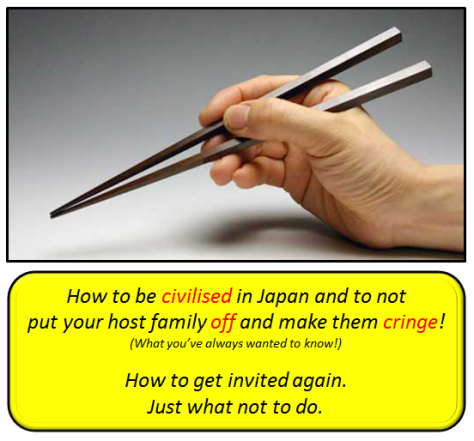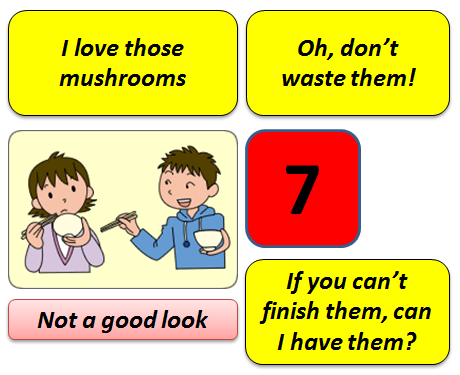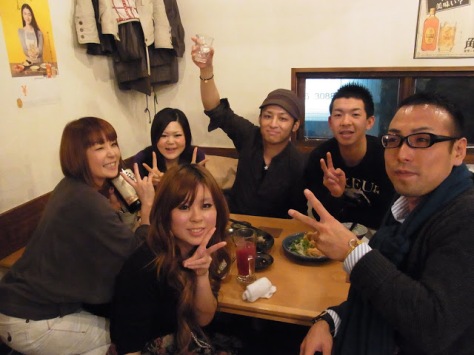Category Archives: KD 3-096 Eating
Briar’s Japanese food choices
Amanda’s shabu-shabu
Table manners
As more and more people travel to Japan, or have Japanese guests over for a meal at home, it is important to know something about table manners. We have table manners as well (although sometimes one wonders) and we have do’s and don’t’s in order to make the meal experience as pleasant as possible for everyone.
One of the most persistent ideas we come across is people telling us that Japanese people, Chinese people or any other Asian people for that matter seem to enjoy burping their way through a good meal, or seem to have the need to round off a good meal that way. What utter nonsense!
Similarly, the slurping sound is only the result of eating very hot noodles when they are at their most delicious! Maybe in a familiar environment some people get carried away, but it is not part of formal eating. We do not appreciate noises and frequent mmyyummyummsmmms sound bites either – whether the guest enjoys it or not. Enough said.
If you want more information on chopsticks, here is the page CHOPSTICKS. Or perhaps you are more concerned about the Green environment GREEN.
We also found some pictures to demonstrate the Anglo-Saxon equivalent. Have a laugh!
The modern disease: I paid for it and I have more than abundant and I am full and I have slaves and my slave will clean it, because I can afford it and I deserve it.
The best one can say about this: it feeds the sparrows.
Here are some left-overs:
Mind you: this is still a bit cute. ..
I tiny little bit cute, if guests are not present…
Yes, here it is still cute for a moment and a laugh at home, but if it is not directed, it could become all of the above.
Welcome to a Japanese inn りょかん ryokan
Japanese inn りょかん
Japanese inn りょかん
Japanese inn りょかん
Japanese inn りょかん
Japanese inn りょかん
Japanese inn りょかん
Japanese inn りょかん
Japanese inn りょかん
Japanese inn りょかん
Japanese inn りょかん
Japanese inn りょかん
Japanese inn りょかん
Japanese inn りょかん
Japanese inn りょかん
Japanese inn りょかん
Japanese inn りょかん
Japanese inn りょかん
Japanese inn りょかん
Japanese inn りょかん
Japanese inn りょかん
Japanese inn りょかん
Japanese inn りょかん
Japanese inn りょかん
Japanese inn りょかん
Japanese inn りょかん
Japanese inn りょかん
Japanese inn りょかん
Japanese inn りょかん
Japanese inn りょかん
These photos were taken in three different ryokan, but that doesn’t matter as the purpose is an overview.
An interesting internal link,
if you want to know more about tatami:
Tatami
Here are two video clips made by two different American companies to promote a stay in a ryokan. One is a young gentleman who speaks perfect Japanese, and the other is a young lady who shows what a stay in an elegant inner city ryokan could be like.
Young gentleman:
Young lady:
Restaurant レストラン
Going to a restaurant in Japan is a pleasant experience.
There are thousands of restaurants to choose from; different types of food and also different prices – from relatively yummy and cheap to stunningly beautifully presented and delivered food at extraordinary prices. Something for everyone. It also depends on the type of restaurant as to what formality is used by the waiter or the waitress.
Just assuming you are visiting a restaurant that fits somewhere in the middle, friendly, but not over the top.
Your friend at the table might ask you:
nani ni shimasu ka?
What are you going to have?
and you would say:
(whatever) ni shimasu.
I’m going to have (whatever).
Very useful phrases. Another fairly common, but more polite phrase you may hear is:
(whatever) wa ikaga desu ka?
Would you care for some (whatever)?
Then you could answer with:
(whatever) o itadakimasu.
I would like some (whatever).
Another way of asking someone about like and dislike would be:
tabetai desu
I want to eat
and
nomitai desu
I want to drink
These two phrases can both be made into a question:
~ ですか。
The Japanese waiter/waitress always repeats the order and then you reply at the end:
onegaishimasu
would you do that for me, please
Now we come to the more difficult part: how to change the direction of the request? For instance: you have had enough, it wasn’t quite what you expected, you didn’t like it all that much… How to do that without offending your hosts:
If you didn’t like it all that much:
chotto
It is a little …
If you thought it was difficult to eat…:
anmari…
It’s a little bit…
If you would like some more:
mo sukoshi kudasai
a little bit more, please.
Home delivery 宅急便 たっきゅうびん
たっきゅうびん
takkyūbin
takkyūbin
Takkyūbin is a service that is used these days widely: it is a courier service. The service is fast; it is outside the Post Office organisation and it is direct. It costs, but the parcel arrives in time and in good order. This type of service has been widely available in Japan for a long time. The Black Cat Service is particularly well-known, but there are others. The system is based on standardised boxes, which is an idea that the Post Office has taken on as well since then.
たっきゅうびん
takkyūbin
The Black Cat Service has vans well-marked and driving about delivering their cargo. Standard-sized boxes further speed up the process. Charges are transparent, the delivery is prompt and without hassles.
たっきゅうびん
takkyūbin
たっきゅうびん
takkyūbin
Even the snow could not keep them away.
This idea of fast service was then borrowed by the “Fast Food Industry”. Menus were designed to cater to the new clientele and with a small charge – of course – they were in business.
Sukiyaki すきやき
Yummy food site!:
And then there is Sukiyaki as we also know it:






























































































































